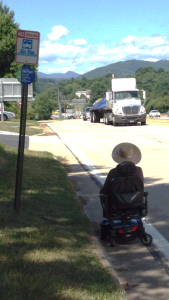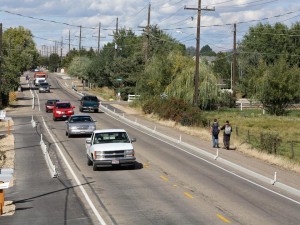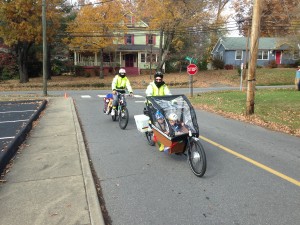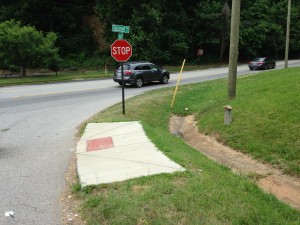The US Department of Transportation Secretary Anthony Foxx unveiled the agency’s new initiative Safer People, Safer Streets to “increase walking and biking and reduce pedestrian and bicyclist fatalities.” It is encouraging to see Secretary Foxx stressing the importance of these topics on the heels of the progress made by his predecessor Ray LaHood. He also spoke about it at the Transportation Research Board’s annual meeting in January 2015.
In 14 years of working directly with traffic engineers, civil engineers, state DOTs and MPOs, I have discovered there are numerous challenges to implementing safe and effective walking and bicycling networks. I challenge USDOT, state DOTS, MPOs and other nationwide partners to strongly consider these 10 efforts they should undertake to make the Safer People, Safer Streets represent the needs and abilities of the bicyclist and pedestrians who depend upon these networks.
- Building with federal dollars? Sidewalks are required! The United States has always used the power of federal funding to enact policy change at the state level. Seat belt laws and speed limits are two areas in which the federal government has threatened to pull funding if states did not enact safer laws. The same is now required of sidewalks.

Federal dollars in urban areas should have restrictions attached that require pedestrian facilities.
- Any non-freeway/non-interstate project undertaken by a state DOT, a city or other agency utilizing federal funds should be required to include sidewalks on both sides of the street, along with appropriate treatments at intersection.
- Victim-blaming cannot be the default position. Too many pedestrian safety campaigns start with blaming the pedestrians for their own deaths. I have seen engineers, law enforcement officers and academics immediately assert that most crashes are deemed the pedestrians fault. The pedestrians are the not the ones wielding a 3,000-pound motorized vehicle with advanced braking systems.
- We must conduct authentic research to truly understand who is at fault in crashes and why. Pedestrian laws should be standardized across all states to the degree that pedestrians are protected, as is done in many European countries. Minnesota’s law requiring motorists to stop when a pedestrian is within the road is a start. Federal funding should be tied to a state’s adoption of these laws, as mentioned above with seat belts and speed limits.
- Focus on small towns, too. Much of my work is conducted in communities with a population less than 20,000. When working on a pedestrian or bicycling plan I try to find research, success stories and practices that small towns can relate to. There are significant gaps in the research and practices that point to small town solutions related to the safety impacts, the health impacts and the economic impacts of walking and bicycling in these communities. When I find such publications they are oftentimes done by an active transportation advocacy group, which makes it difficult (sometimes) to make a technical argument for biking and walking facilities because the analysis not on-par with what traditional highway research.
- Walk and Bike Assessments identified in the Safer People, Safe Streets publication are critical to getting a cross-section of professionals, elected officials and advocates to better understand how to make our streets safer. Pilot studies should be done in small towns in addition to the cities already undergoing pilot assessments. USDOT and CDC should organize a research program focused on active transportation for small towns to fill gaps in research.
- Develop alternative, low-cost sidewalk design standards. When I worked for Ada

These alternative sidewalk designs are employed across the Boise region (Photo: Ada County Highway District)
County Highway District in Boise, Idaho, we embarked on a program to construct sidewalks using alternative design standards to help make better use of limited funding. These projects included wider shoulders with extruded curbing between the travel lane and the shoulder. I try to showcase how these work when consulting to many towns, but AASHTO and many state DOT design standards preclude such low-cost, effective alternatives because a curb, gutter and sidewalk is the only facility that is allowed.
- USDOT should make a call for innovation to gather information on how communities have constructed alternative, low-cost walking facilities and work to make them part of the standards. They can be constructed to meet ADA requirements and should reflect the context of the community.
- Stop applying highway-grade analysis to walking and bicycling facilities.It does not surprise me when I hear a community say, “We will never build another sidewalk, a greenway or a bicycle lane with federal funding. It takes too long and costs too much.” Our federal funding requirements and project analysis techniques were developed for highway-grade investments. DOTs assign environmental review staff and engineers to oversee biking and walking projects after they spent a career reviewing highway projects. Their default position is to kill the fly with a hammer. Based on analysis we did in Boise, we found that the buying power of a federal transportation dollar was only 50 to 70 cents because of all the red tape.
- USDOT needs to publish guidance for bicycling and walking projects to truly streamline the environmental review process. A sidewalk in an urban area should not require 10 years of TIP processes and environmental review. State DOT professionals need to be trained on how to review these projects for what they are instead of equating them to bridge, highways and interchanges.
- Design for the users, not the manual. North Carolina DOT’s Complete Streets policy is

The growth in the number of people traveling by bike means that the design of bicycles are changing. A 4-foot wide bike lane can no longer be the default if we are to keep bicyclists safe.
okay for a DOT, but it’s not great. The Planning and Design Guidelines produced to help bolster the policy advance the issues but make no mention of the dimensional needs of a pedestrian or bicyclist. It disconcerting when engineers default to the minimum dimensions for sidewalks and bike lanes, which is unacceptable and unsafe in most conditions alongside multi-lane highways.
Bicycle design is becoming more diverse. A four-foot wide bike lane is barely wider than many bicycle trailers or chariots; more and more bicycles have handlebars that are more than 30 inches wide. A five-foot wide sidewalk is not wide enough for me to walk side-by-side with my daughter.
- USDOT must emphasize the operational needs of pedestrians and bicyclists in a form akin to how they address a “design vehicle.” Focus on the width of different bicycles in the same way engineers address the width of trucks. The language in Safer People, Safer Streets regarding mid-block crossings is encouraging. I challenge USDOT to not allow the traffic engineers to continue to control the discussion by working to suppress walking and bicycling and instead of accommodating it properly.
- Trust people more than computer models. We are comfortable basing billion-dollar highway investment programs on what a seriously-flawed travel demand model spits out for a traffic volume 20 years in the future, but traffic engineers reject a pedestrian signal or crosswalks request when a count falls one pedestrian short of what MUTCD tells us is acceptable. This must stop. Traffic engineering principals developed over decades of reviewing motorist behavior cannot and should not be applied to pedestrian and bicyclist behavior. Their needs are different and they do not act (and should not be expected to act) like motorists.
- USDOT should develop guidelines that make it acceptable to project pedestrian and bicyclist demand when evaluating projects and define a margin of acceptability. Pedestrian crossing demand along an entire block face should be considered when there is a lack of safe crossings instead of evaluation only occurring at a specific cross street.
- Enforce the Americans with Disabilities Act. Part of my skepticism with Safer People,

Should we be satisfied that DOTs can build this and walk away?
Safer Streets is that USDOT and the Department of Justice have a poor track record in enforcing the existing laws related to keeping pedestrians safe. It is appalling to see how many state DOTs and municipalities are still not building sidewalks, curb ramps and pedestrian buttons in compliance with the Americans with Disabilities Act. When I quiz my state’s FHWA representatives on this, they state it is not their job to review the design of projects for ADA compliance (then they proceed to enforce AASHTO Green Book “guidelines” as law). In an ADA-related presentation from FHWA at the 2014 North Carolina Association of MPOs conference, the FHWA representative said it was okay that DOTs had not complied with ADA for the past 20 years and recommended they simply do a Transition Plan to keep from being sued.
- Enforce the Americans with Disabilities Act! Buy smart levels (or download a $0.99 phone app to measure slopes)!
- Restrict state DOTs from applying a double standard to active transportation. In North Carolina, our state’s policy mandates that municipalities pay up to 40% of the total cost for sidewalks to be included in projects the DOT is managing. This occurs even as DOT is being reimbursed 80% of the project costs from federal funding sources. Therefore, is appears cities are over-matching for the DOT in order to subsidize a highway widening project.
Really. That’s what is occurring.
Further, North Carolina’s DOT restricted active transportation expenditures from being used for right-of-way acquisition as a reimbursable expense with federal funding. This also occurs in other states. It’s asinine. These policies apply to no other realm of transportation funding in North Carolina or other states.
- USDOT should document the many double standards that are present in various state DOT policies that discourage active transportation facilities investment or place an undue burden on municipalities and other partners. State DOTs should be restricted from enacting policies on active transportation facilities that place such burdens upon active transportation projects when federal funding is being used.
- Complete Streets mean so much more than the presence of sidewalks and bike lanes.Just because a sidewalk and a bike lane does not mean it is “complete.”I cringe every time I see a presentation at a conference or in a webinar that showcases a community’s or DOT’s “Complete Streets” project. These often include the same old multi-lane highways with a four-foot wide bike lane and five-foot wide sidewalk tacked onto the side. Engineers have been allowed to proceed in this manner and get rewarded with “Complete Streets” accolades even when bicyclists are required to ride in four-foot lanes next to 55 mph traffic and pedestrians have to wait 180 seconds to cross an intersection.
NC Highway 54 in Chapel Hill, NC, is a noteworthy of these egregious practices. The design of the pedestrian and bicycle facilities along the route are not bad. Yet, at Environ Way (an intersection that links a neighborhood to a mixed use development) the pedestrian has to wait 4 minutes during a typical signal phase to simply cross a 115-foot wide highway at an intersection where only median u-turns are allowed.
- USDOT should spend considerable time and resources to identify how to make streets that are truly complete and operate in consideration of all users. The simple presence of a facility is not enough if the other details of that facility are inadequate to all users of all ages and all abilities AT ALL TIMES.
I’m looking forward to continued progress by USDOT and hope advocates, DOTs and communities will communicate on the diverse needs of bicyclists and pedestrians to make streets safer for all people.
